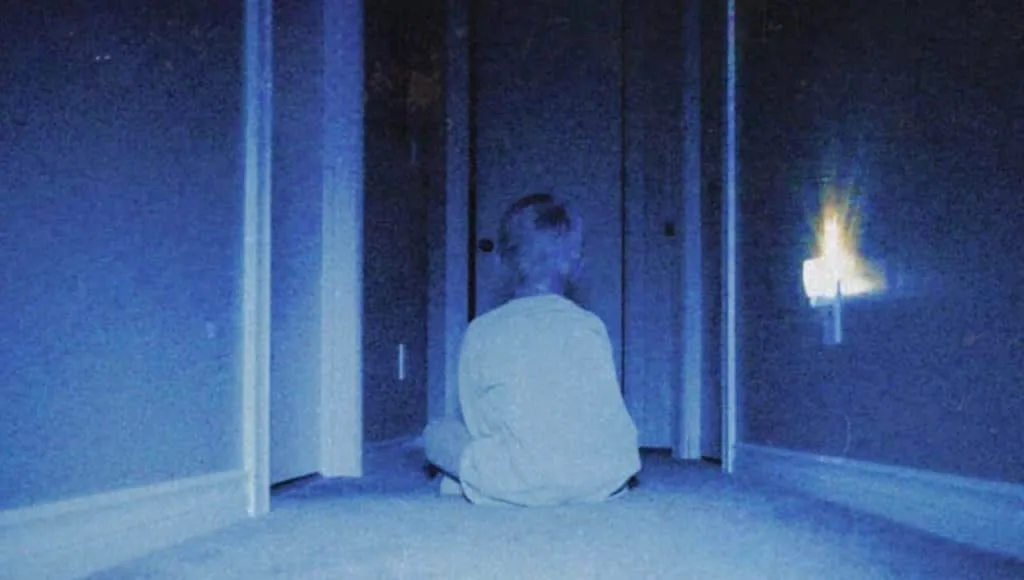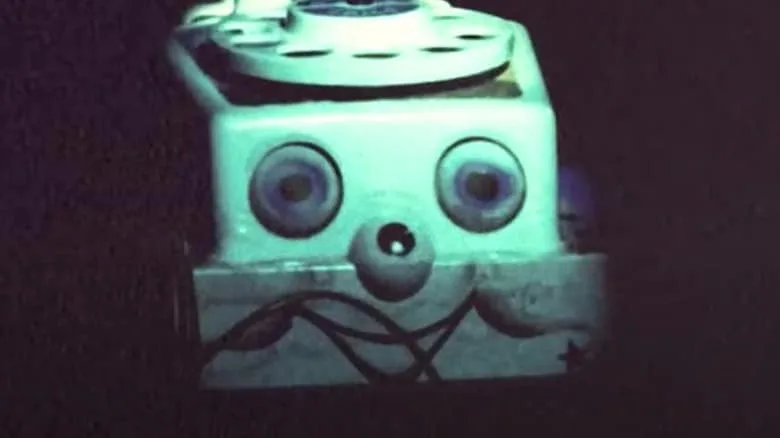
To do Skinamarink (2022) credit, all of its tedious blunders are strongly represented in the first few minutes; you don’t need to wait the full one hundred to feel cheated. The warning signs are there, and they’re there good and early: the opening credits which proclaim that it is ‘1995’, though breaking that spell by trumpeting the film’s Covid-19 compliance; the oddly oblique shooting style; the fetishised VHS fuzz; the endless background noise of retro, copyright-free cartoons. Should you wish, as the hundred minutes amble slowly by, you may choose to fill in the blanks here – essentially, to write the film you have in front of you. Good for you if you opt to do that, though here’s a reminder: this is not your job. If the film’s piecemeal allusions don’t land through their own merits, then perhaps they don’t deserve to land.
With all of that in mind, here’s an attempt to describe what goes on in Skinamarink. There’s a family, two kids and their parents, living in a house with wood-panel walls and the correct amount of analogue technology to pass muster. It looks as though the children are getting ready for bed in one instance; we never see them, by the by, or indeed their parents, except for their legs (or backs), as if this is a Tom & Jerry cartoon. A distinctive aesthetic shooting choice which underlines the disconnect between children and their parents, by emphasising physical distance? A representation of the uncanny, depriving the audience of visual and narrative clarity? Or just an annoying stylistic tic which persists for no good reason, giving us more visual information about ceilings than it does characters? You be the judge. It feels reminiscent of the grainy footage in Paranormal Activity, only grainier, and as if the camera has fallen down.
Anyway, by peering deep, deep into these shots of floors and ceilings, you glean that there’s a brother and sister, Kevin (who fell down the stairs and hit his head recently, though when exactly isn’t clear) and Kaylee who, were she ever to escape this house, would spend the rest of her life spelling out her name in a world full of Kayleighs. For, when the children wake up in the middle of the night and wander about a bit, they discover that their parents seem to be missing. The windows are missing too, leaving the children stuck in a house with what may be a demon who moves Lego about, even anachronistic bits of Lego, because demons care not a fig for these kinds of errors.
That’s it.
It seems that a glitch during its run of online screening festivals allowed people to illegally download Skinamarink, at which point its reputation for scares took off; even a cursory look at social media reveals an already baffling amount of traction for this title. Whatever the circumstances of the glitch, it’s done the film little harm in terms of hype. Hype, by the by, which many indie film titles spend years trying to generate, often failing, to their detriment. That’s the great pity of this; through something quite arbitrary, this film is everywhere. You may feel that it deserves to be, but for this reviewer it has too many hallmarks of creative apathy, and is certainly a stretch for a Shudder release, which tend not to be particularly dull.
So much about this film is pure irritation. For instance, this masturbatory obsession with grainy, pockmarked film, emulating the worn reels and videos of the 70s, 80s and now the 90s is incredibly formulaic. Sure, in some respects this can tap into early memories of watching horror, recalling those third and fourth generation copies of illicit titles, but overall, then as now, it’s actually a bit annoying – at least in the quantities we see in modern indie cinema. Skinamarink is certainly not alone in this, but it takes it to the next level. The grain here is so pronounced, you can barely make out what’s happening. Again, this invites you to do the work, to flesh out the glimpses of something-or-other. The alternative is that it locks you out completely, because you simply can’t see. It’s like putting blinkers on a horse. This is all made more exasperating when you consider the possibility that this isn’t even nostalgia, just a hyperbolic version of it as imagined. Ditto this obsession with analogue technology – the film dotes lovingly on old tellies and a landline phone more than most other things it features – and the sheer amount of filler director (and writer!) Kyle Edward Ball has taken from rights-free old cartoons. Most of the dialogue in this film actually comes from the cartoons which are on perpetually in the background. Presumably, as well as not costing a damn thing, they’re intended to generate atmosphere. But for what? What here requires it? Perhaps we should be grateful it’s not Night of the Living Dead being cribbed for free yet again.
Skinamarink quite likely suffers through comparisons to Enys Men, another ‘experimental’ title which has coincidentally just been released. It, too, is a time capsule full of nothing but hot air; release dates aside though, it seems that by being openly experimental, a film can get away with a lot. Here are a few of those things: being about nothing; showing us nothing; sticking with student film quality throughout as if it’s a badge of gonzo honour. Now ‘slow cinema’ is also being vaunted as a badge of honour; combine that with experimental film, and it seems you get more nothing, for longer.
The thing is, horror doesn’t work like that. Horror perhaps could work, somehow, along the lines of slow TV, but for the most part, it isn’t a slow train ride, whereas Skinamarink is. But more pertinently, this seems to be a film about children’s imaginations. Really? Children’s imaginations weave incredibly vivid narratives – narratives which horror fans often chase forever. It’s something which often drives their love of the genre. Many excellent horror films have captured something of that barely-remembered terror, and we love those films for it. Skinamarink fails at this, offering instead the white noise of nothingness which could only come from jaded adulthood.
Skinamarink is available now on Shudder.
